This page may contain affiliate links, which means I will make a small commission for products purchased through my link.
A classic Japanese noodle dish made vegan, gluten-free, and refined sugar-free. This Vegan Zaru Soba is incredibly easy to make, full of flavour, and just so refreshing! Ready in just 10 minutes!

What is Zaru Soba?
Let’s chat about Zaru Soba – a classic Japanese noodle dish that’s basically a noodle party on a plate! “Zaru” refers to the bamboo draining basket traditionally used to drain and cool the cooked soba noodles. In this dish, the buckwheat noodles are served cold with a fancy dipping sauce and a whole bunch of toppings, like scallions, sesame seeds, nori, or spices – whatever floats your foodie boat!
And guess what? I’m using 100% gluten-free Soba noodles, so if you’re not besties with gluten (like yours truly), I’ve got you covered. When it’s time to dig in, grab some cold soba noodles, dip them in that tasty sauce, and go wild with toppings. Flavorful and so refreshing, especially on a scorching day! 🍜🌞
What Makes This Recipe Great
Growing up in a part Japanese household, I ate a lot of zaru soba. Today, in true Veggiekins fashion, I’m bringing you this amazing Vegan Zaru Soba recipe that is also gluten-free! It’s refreshing, light, and very simple. However, the traditional version is surprisingly not vegan or gluten-free friendly. So leave it to your girl to fix that right up!
See, buckwheat alone (despite the name containing the word wheat) is naturally gluten-free, but most buckwheat noodles have added wheat flour as well. The sauce, called mentsuyu, (which is a light soy-based sauce, also contains gluten and bonito flakes or fish stock/dashi (this is very commonly used in Japanese cooking to add umami and depth to dishes).
The good news is I’ve not only veganized the recipe but have also found a way to make it 100% gluten-free. I couldn’t be more excited to share this recipe with you, and although it’s a simple recipe, it’s near and dear to my heart.
This Vegan Zaru Soba is made with 100% buckwheat noodles, gluten-free sauce ingredients, and a vegan fish sauce replacement that nails the flavour on the head!

The Details
- The recipe is vegan, gluten-free and oil-free. It is best enjoyed on the spot but can be batch-prepared for parties or meals for a family!
- Making Vegan Zaru Soba takes only about 15 minutes to make in total, making it a wonderful go-to meal for hangry moments or quick lunches.
- Buckwheat → is a surprising source of protein, fiber, and vitamins like thiamin and folate. As I mentioned earlier, it is 100% gluten-free as an ingredient, despite what you may think! It has a delicious, toasty flavor to it, and I absolutely love it.
Ingredient Notes
- 100% buckwheat flour noodles: I like this brand.
- Mentsuyu sauce
- gluten-free soy sauce: If preferred, use a low-sodium version.
- mirin: I like this brand.
- granulated sugar of choice: You can also use coconut sugar.
- vegan fish sauce: I used this brand of vegan fish sauce, but any will do. To make your own, soak a 1-inch x 1-inch piece of dried kombu overnight in 1/4 cup water and then boil it with the soaking water over medium heat for a few minutes.
- garnish: Scallions/green onions, black and white sesame seeds, thinly sliced nori (seaweed), and/or shichimi (Japanese 7-spice seasoning).
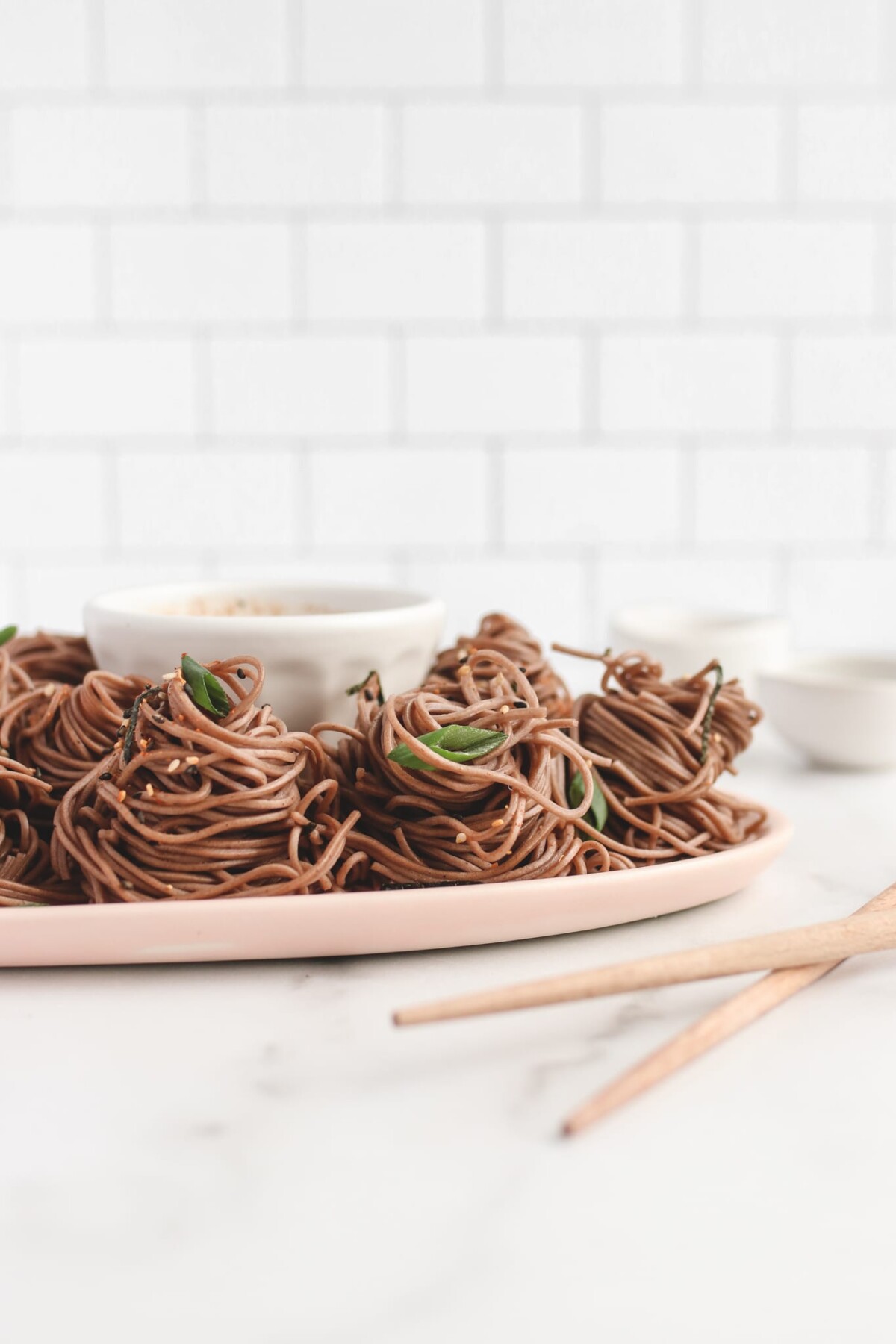
How to Make Zaru Soba Step-by-Step
- In a saucepan, prepare the sauce by mixing all ingredients together until smooth. Bring to a quick boil, then transfer to a bowl and refrigerate, or add ice to chill. When ready to enjoy, add iced water to the sauce to achieve your desired taste/salt preference.
- Boil the noodles according to package instructions in a large pot of water. Strain, and rinse with cold water once cooked. Separate into little noodle nests to avoid clumping. You may also place it on top of ice to keep it cold.
- Add your desired garnish and toppings, and enjoy!
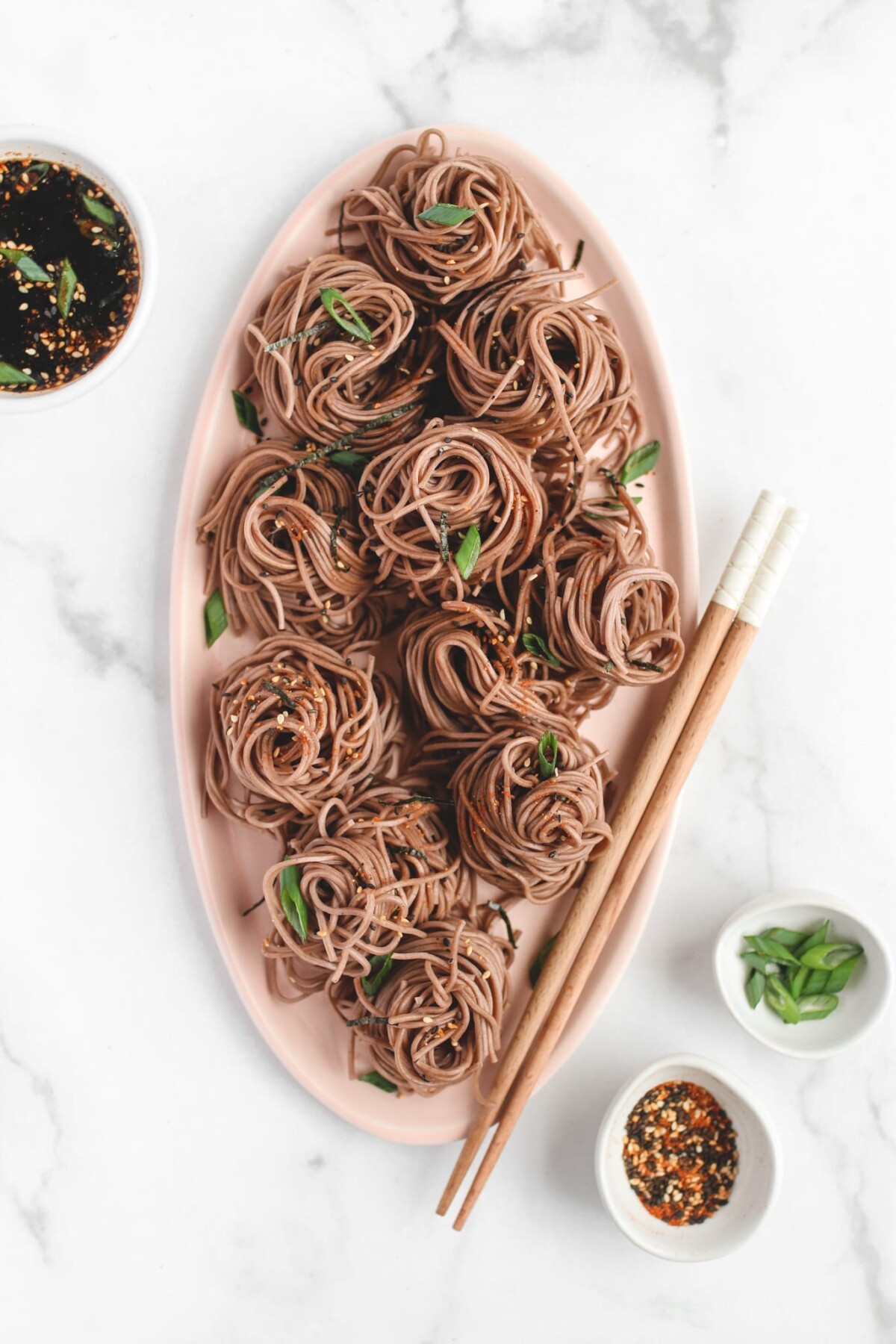
Secrets to Success
- To ensure your recipe is 100% gluten-free, make sure you look for a 100% buckwheat noodle. I used this brand, and it’s absolutely delicious! Using an alternative noodle is possible, but I wouldn’t recommend it if you want the authentic experience and texture.
- You can usually find a 100% buckwheat noodle at a Japanese grocery store if there’s one near you, but if not, I’ve linked a brand you can find on Amazon!
- If you’d like to opt to leave out the vegan fish sauce, you absolutely can! I’ve included notes in the recipe if you decide to make your own umami stock using dried kombu, soaked and simmered with a small amount of water.
Serving Tips
- Serve cold with your favorite toppings and the dipping sauce!
Storage Tips
- Store the cooked and chilled soba noodles in an airtight container or a plastic zip-top bag. You can store the noodles as a single large batch or portion them into serving sizes. Store in the refrigerator and eat within 1-2 days.
- Because this dish is served cold, there are no reheating instructions. Serve cold with toppings and sauce.

Recipe FAQs
In Japanese, when you say “Zaru Soba,” you’re basically talking about something cool – like, literally cool! “Zaru” refers to this neat bamboo tray that’s been the go-to for draining and cooling down soba noodles. So, when you order “Zaru Soba,” you’re getting these cold soba noodles served up on that bamboo beauty, usually with a tasty dipping sauce (tsuyu) and all sorts of yummy toppings.
Both “Zaru Soba” and “cold soba” refer to chilled soba noodles. But here’s the deal: “Zaru Soba” is served on a bamboo draining tray for that extra traditional vibe. “Cold soba” is the laid-back version served up on a regular plate or bowl. The big difference is really in the presentation, not the noodles themselves.
More Japanese-Inspired Recipes
Japanese Sweet Red Bean Soup with Mochi
If you try this recipe out, tag me on Instagram @veggiekins so I can see your delicious re-creations and for a chance to be featured! As always, I love it when you share your reviews in the comments below, and if you make any fun substitutions, let me know how it worked out below too!
This post may contain affiliate links.
Easy Zaru Soba Recipe ざるそば (Vegan & Gluten Free)
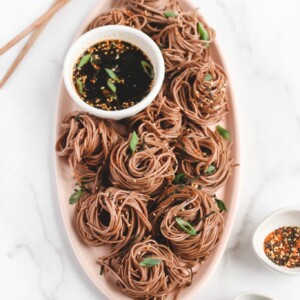
Ingredients
- dry ingredients
- 8 oz 100% buckwheat noodles or as much as you'd like to serve (I also like this brand)
- sauce mentsuyu
- 1/4 cup gluten free soy sauce
- 1/4 cup mirin I like this brand
- 1/2 tbsp granulated sugar of choice you can use coconut sugar
- 1-2 tsp vegan fish sauce I used this brand of vegan fish sauce, but any will do. To make your own, soak a 1 inch x 1 inch piece of dried kombu overnight in 1/4 cup water and then boil it with the soaking water for a few minutes
- garnish optional
- scallions thinly sliced
- black and white sesame seeds
- thinly sliced nori
- shichimi japanese 7 spice seasoning
Instructions
- Prepare sauce by mixing all ingredients together until smooth. Bring to a quick boil, then refrigerate, or add ice to chill. When ready to enjoy, add iced water to sauce to achieve your desired level of flavour/saltiness if needed.
- Boil noodles according to package, strain and rinse with cool water once cooked. Separate into little noodle nests to avoid clumping. You may also place on top of ice to keep cold.
- Add your desired garnish and toppings and enjoy!
Notes
Secrets to Success
- To ensure your recipe is 100% gluten-free, make sure you look for a 100% buckwheat noodle. I used this brand, and it’s absolutely delicious! Using an alternative noodle is possible, but I wouldn’t recommend it if you want the authentic experience and texture.
- You can usually find a 100% buckwheat noodle at a Japanese grocery store if there’s one near you, but if not, I’ve linked a brand you can find on Amazon!
- If you’d like to opt to leave out the vegan fish sauce, you absolutely can! I’ve included notes in the recipe if you decide to make your own umami stock using dried kombu, soaked and simmered with a small amount of water.
Serving Tips
- Serve cold with your favorite toppings and the dipping sauce!
Storage Tips
- Store the cooked and chilled soba noodles in an airtight container or a plastic zip-top bag. You can store the noodles as a single large batch or portion them into serving sizes. Store in the refrigerator and eat within 1-2 days.
- Because this dish is served cold, there are no reheating instructions. Serve cold with toppings and sauce.
Nutrition information is automatically calculated, so should only be used as an approximation.
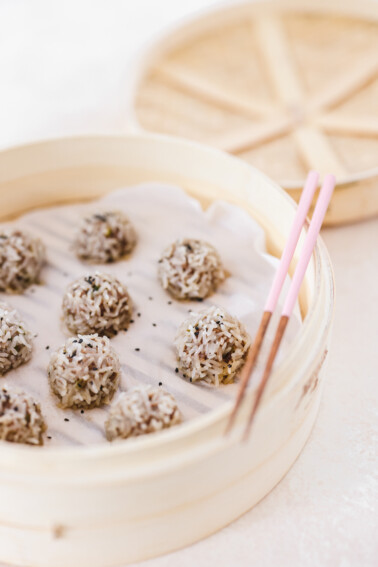
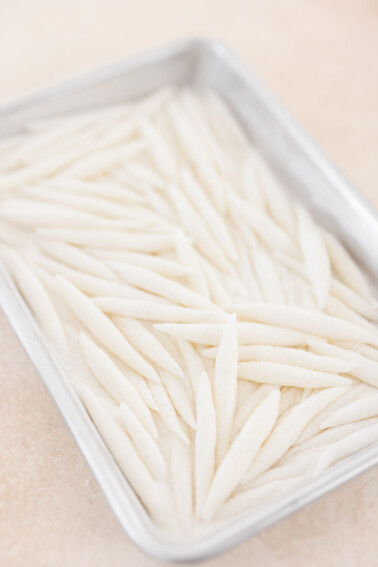
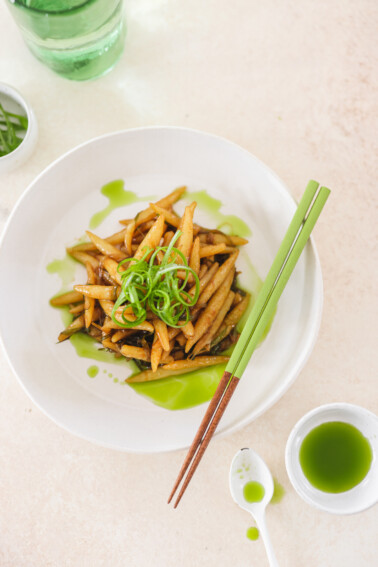
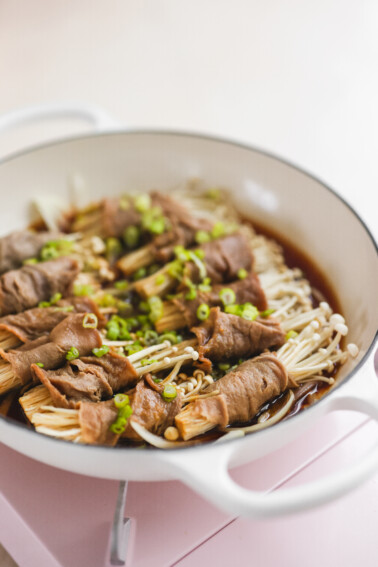
5 Comments